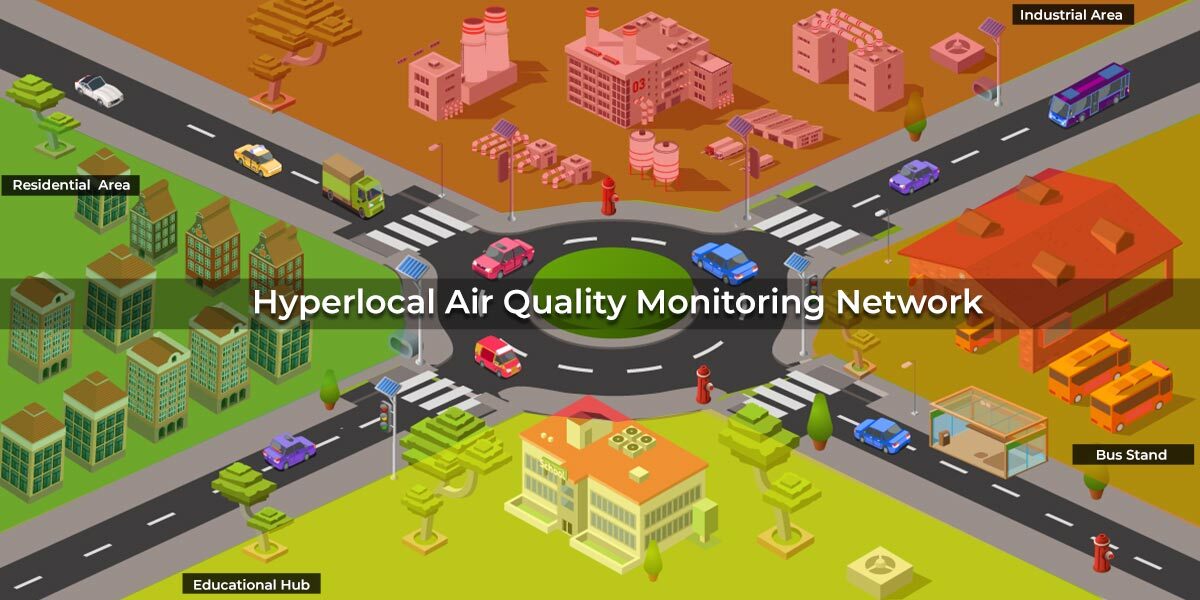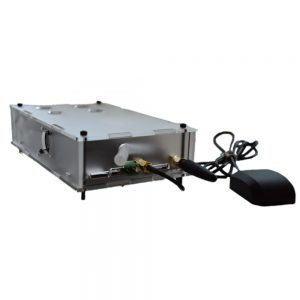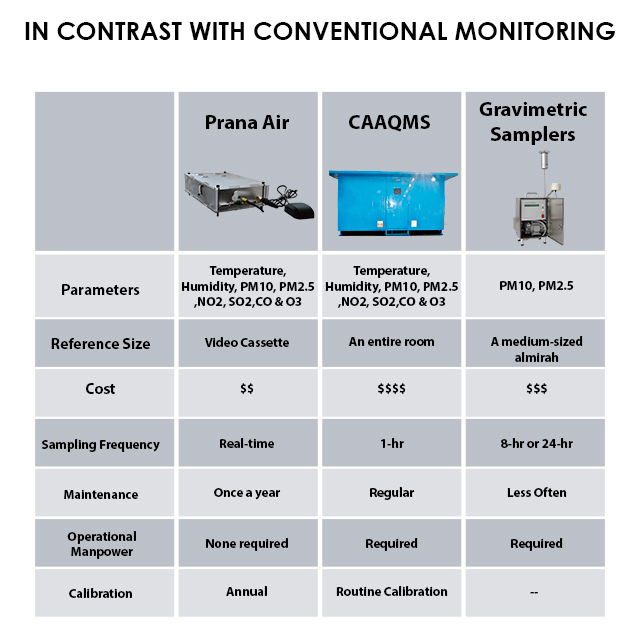Until now, air quality monitoring was limited to elaborate monitoring set-ups and a diluted network. However, the outbreak of sensor technologies has unlocked new horizons in air monitoring at even granular levels. Hyperlocal air quality monitoring is a fresh concept. But what is it? Read more to find out.
Air quality monitoring is a mighty key that can unlock the atrocity of air pollution. Air quality is dynamic. Numerous meteorological, topographical, natural, and anthropological factors determine the air quality trends of a location. There can be spatial variation in air quality data within minute ranges. Extensive air quality data is essential in laying the foundation of a concrete air quality management plan. Conventionally, reference-level analyzers gave the required data insights. However, these analyzers cost an exorbitant amount. Hence, their utility narrows down to fewer numbers and locations.
What are the demerits of traditional air quality monitoring?
Most of the air quality monitoring stations in the cities are allocated in their accessible areas. Thus, these stations that monitor the ambient air quality are not indicative of the pollution at the street-level. Due to the exhaustive cost and sparse network of the Continuous Ambient Air Quality Monitoring Stations (CAAQMS), they fail at furnishing a thorough reflection of the status of air quality. The pollutants entrap themselves in the condensed streets and create an impenetrable blanket of pollution. These dense avenues remain out-of-reach for traditional air quality monitors.
As a result, authorities fail to lay down a concrete plan of action against air pollution. Therefore, there has not been any significant impact of their policies in improving the quality of air and thus, life. Air pollution continues to be an invincible arch-nemesis, striking down the health and economy together.
However, sensor-based monitoring devices have emerged as the knight in the shining armor. Not only are they compact and portable, but they are also cost-effective and easy-on-maintenance. This state-of-art advancement has led to the rise of a new concept called hyperlocal air quality monitoring.
What is Hyperlocal air quality monitoring?
Hyperlocal air quality monitoring concocts a web of many such mobile or low-cost instruments. Such a dense network will be instrumental in providing a comprehensive review of human exposure to air pollutants. Hyperlocal air quality monitoring will enable air quality monitoring in the untapped parts of a city. It will facilitate the formation of specific counter-strategies to ameliorate the impacts of air pollution. Going hyperlocal would tend to make the invisible visible.
Studies indicate that uneven distribution is a characteristic of fast-traveling air pollutants. Air pollution can be up to eight times worse on one extreme of a block than another. By street-level or hyperlocal air quality monitoring, we tend to bring high spatial resolution (every 30-100 meters, for instance) and high temporal resolution (variation every minute or few minutes) to the forefront.
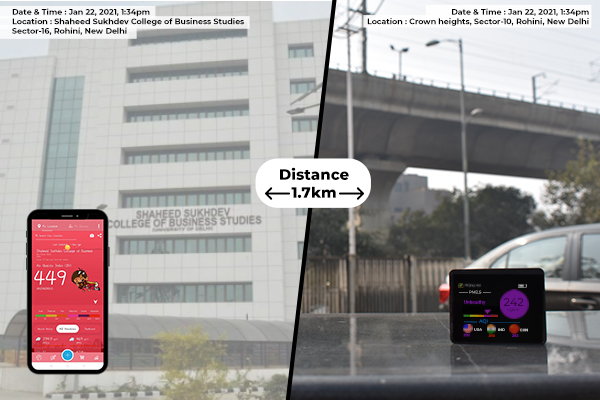
Difference in real-time air quality index within a spatial range of 1.7 km. Hence, a few stations cannot be descriptive of a large area.
What does it mean to go hyperlocal?
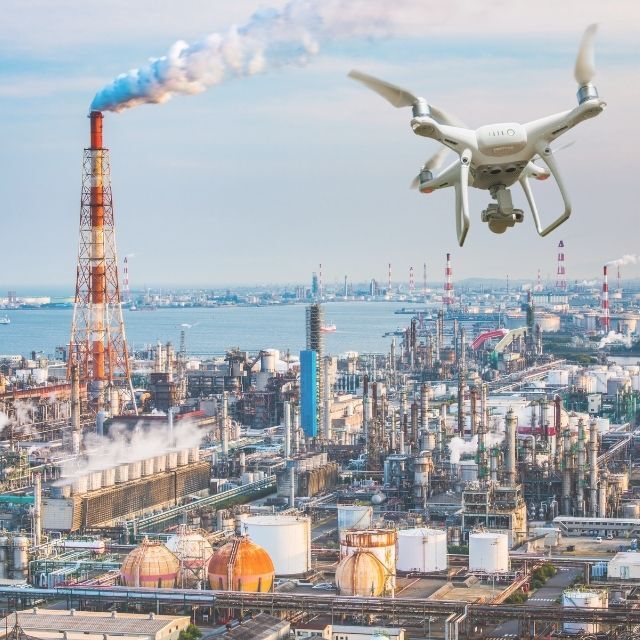
A mobile AQM instrument can be latched on a drone. Hence, a cost-effective means of hyperlocal air monitoring.
- Sensor-based air monitoring
- Facile deployment
- Versatile configuration
- Robust data
- Data with a high spatial and temporal resolution
- Radical data-analysis
- Scope of ambiguous data-interpretation
- More extensive monitoring
- High accessibility through a dashboard
- Internet of Things (IoT) based air quality network
- Cost-effective air quality monitoring
Pros of hyperlocal air quality monitoring
- Easy identification of air pollution hotspots in a city;
- Discern the most susceptible groups;
- Specific building codes, zoning designations, and land use for high pollution areas;
- Enforcement against stationary pollution sources or repeated offenders;
- Enhanced public health interventions based on air quality forecasting;
- Ease in pollution- and health-based exposure studies;
- Discrete transportation planning;
- Improved traffic management planning in hotspot areas. For instance, re-routing and restrictions on idling, etc.;
- Increase in community awareness due to a more concentrated air monitoring network.
Prana Air’s venture into hyperlocal air monitoring
All this pointed out the need for such an entwined network. Therefore, we came up with a solution.
Our new petite instrument is the upgraded, compact, and cost-effective version of the hefty mobile air quality monitoring instrument (latched on to a van). It performs the heavy-duty functions of monitoring all major outdoor air quality parameters remotely. It has state-of-art sensors that measure thermal parameters (temperature and humidity), particulate matter (PM10, PM2.5, PM1), and gaseous parameters (NO2, SO2, O3, and CO). Moreover, it can be lodged on any mobile vehicle, even a drone, thus enabling optimum air quality monitoring in the areas which are non-reachable by a bulky van. This technology with a precise one ppb resolution would revolutionize the domain of mobile air quality monitoring.
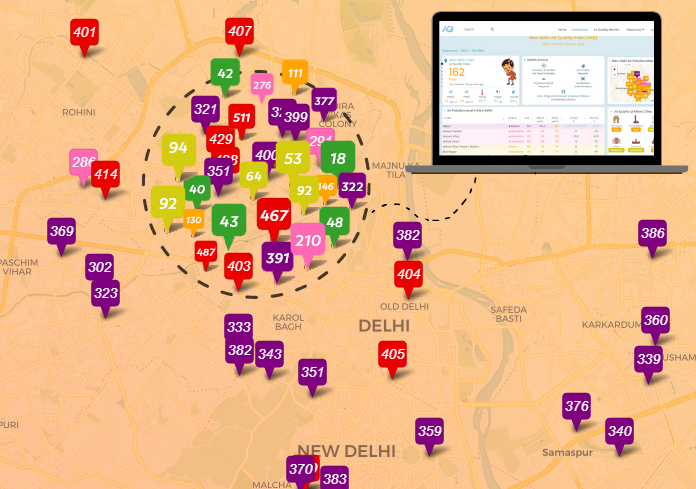
A representative image of air monitoring through an intense network of Prana Air instruments and AQI dashboard.
Our instrument in contrast with conventional means of air quality monitoring
Our instrument enables street-level air quality monitoring which gives us the edge over the traditional methods. Moreover, since it facilitates mobile air monitoring, it offers to save the cost of installation and maintenance. However, there are many other distinctions that are summarized in the table below.

